Did you know that the global market for fabric structures, including coverall buildings, is projected to grow significantly in the next decade? This surge reflects an increasing recognition of their versatility and resilience, particularly in the face of diverse weather conditions. Coverall buildings, known for their adaptable design and durable materials, offer unique solutions to weather-related challenges. This article delves into the heart of what makes these structures so reliable, exploring everything from their basic design principles to their ability to withstand various climatic conditions.
Understanding Coverall Buildings
Definition and Basic Characteristics
Coverall buildings, characterized by their distinctive, semi-circular shape and flexible covering materials, offer a modern approach to building design. These structures are defined by their adaptability and cost-effectiveness, providing solutions for a range of applications, from agricultural storage to industrial workspaces.
Materials Used in Construction
The resilience of coverall buildings begins with their construction materials. Typically utilizing high-quality, weather-resistant fabrics stretched over a robust frame, these buildings are designed to withstand environmental stressors. The materials are not only durable but also provide insulation and natural light, enhancing their efficiency.
Comparison with Traditional Buildings
Structural Differences
Unlike conventional buildings, coverall buildings boast a unique aerodynamic design. This shape plays a crucial role in their ability to resist strong winds and heavy snow loads, making them a more reliable choice in extreme weather conditions.
Material Durability in Various Climates
The materials used in fabric buildings, such as polyethylene or PVC fabrics, are specifically chosen for their resistance to corrosion, UV rays, and moisture. This contrasts with traditional building materials like wood or metal, which may deteriorate more quickly under harsh weather conditions.
Weather Resilience of Tarp Buildings
Performance in Extreme Weather Conditions
Coverall buildings excel in extreme weather. Their design allows for effective snow shedding and wind deflection, ensuring structural integrity during blizzards or hurricanes. The flexibility of the fabric also plays a critical role in absorbing and dispersing the energy from high winds, preventing damage.
Longevity and Maintenance in Different Weather
In terms of longevity, these structures can last decades with minimal maintenance, even in varying climates. Regular checks and simple upkeep like cleaning the fabric and inspecting the frame keep these buildings in optimal condition, irrespective of weather extremes.
Practical Applications and Customization
Use-Cases in Diverse Climates
From the scorching heat of desert landscapes to the frigid temperatures of the Arctic, coverall buildings have proven their versatility. They serve as aircraft hangars in snowy regions, agricultural storage in rainy climates, and sports facilities in areas with fluctuating weather patterns.
Customization for Climate Adaptability
One of the key advantages of coverall buildings is their customizability. Depending on the climate, these buildings can be outfitted with ventilation systems for hot weather, insulated covers for cold environments, or reinforced frames for windy locales.
Construction and Adaptability
Construction Process and Time Frame
The construction of a coverall building is notably swift and efficient. Unlike traditional construction, which can be hindered by bad weather, the assembly of these structures is less weather-dependent, allowing for year-round building opportunities.
Flexibility in Relocation and Expansion
Coverall buildings are not only quick to erect but also offer the flexibility of relocation and expansion. This adaptability is particularly useful for responding to changing needs or environmental conditions, making them a practical solution for a variety of scenarios.
Future Outlook
Summary of Weather Resilience
In summary, coverall buildings represent a fusion of innovation, resilience, and adaptability. Their ability to withstand diverse weather conditions, coupled with their cost-effectiveness and versatility, positions them as a formidable solution in modern construction.
Future Trends and Developments
As we look to the future, the evolution of coverall building technology is likely to focus on enhancing weather resilience and eco-efficiency. This progression will further cement these structures as a key player in the global push towards sustainable and adaptable building solutions.


